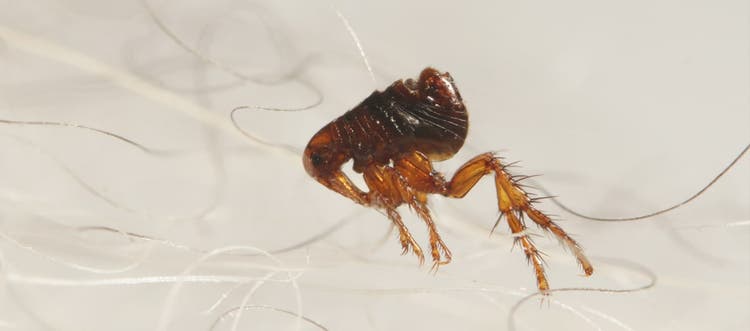Fleas and bed bugs are both annoying little insects. Here's what you need to know about where they live, what their bites look like, and how to get rid of them.
Fleas are one of the most common annoyances for pet owners. They make your pet itch, can cause infection, require treatment shampoos and vet visits, and can infest your entire house. Unfortunately, fleas aren't the only annoying biting insects that can take over your home — you might also be sharing your living space with bed bugs.
Fleas vs. Bed Bugs
First things first — how similar are these bloodsuckers? Fleas and bed bugs are alike in that both:
- Are wingless insects
- Are great at hiding
- Require blood meals from a warm-blooded host
- Hitchhike their way into your home (fleas will hop on a pet or person, and bed bugs hide in furniture, luggage, or another object)
- Defecate something called "frass," which looks like small specks of dirt or clumps of rust
There are a lot of similarities, but there are differences, too. Fleas:
- Jump on pets
- Live on cats and dogs and do not leave the pet once they start to blood feed
- Require blood meals only as adults
- Can cause skin issues, flea allergy dermatitis, and transmit tapeworms if ingested
- Are small and often hard to see, and they navigate through fur and hide
Close up of bed bug Cimex lectularius
Bed bugs:
- Crawl
- Prefer humans and crawl onto your skin only to feed on your blood (they don't live on you)
- Require blood meals at all five stages of their development
- Cause red, itchy areas at the bite sites
- Are slightly larger than fleas, and flat, which allows them to navigate under floorboards or other tight spaces
Is It a Flea Bite or a Bed Bug Bite?
If you go to sleep and wake up to find red, itchy bites on your body, chances are you have bed bugs. These insects like to hide in dark, well-covered locations such as floor cracks or baseboards and come out at night. Bed bug bites can be found all over your body and generally appear as small, slightly raised red blotches on your skin — the bites are typically present in groups of two to four with a slightly linear pattern. Another way to tell if you have bed bugs is to inspect your mattress, box spring, and headboard. Bed bugs shed their skin (like a snake) as they grow, so you can often find these exoskeletons in your sleeping area — or even the bed bugs themselves.
Fleas can bite humans, but they prefer pets. Flea bites usually appear as a cluster of small red dots around the ankles or feet, and can occur anytime — day or night. Scratching them can lead to infection.
How Can I Get Rid of Fleas and Bed Bugs?
If you have a flea infestation, treating your pet is important. Your dog could benefit from a flea shampoo but more than likely will need a flea preventative applied, such as a collar or topical. If the fleas have spread to your home, you'll want to thoroughly clean your carpets and other areas where pets frequent. You may want to consider vacuuming and applying carpet and upholstery flea sprays.
With bed bugs, the priority is getting rid of the bugs in your house. If you still have bed bugs after trying to solve the problem with carpet and upholstery sprays, you may need to consult professional pest specialists.

Advantage® Household Spot & Crevice Spray
Kills fleas, dust mites and brown dog ticks in hard-to-reach places in your home. Not for use on pets. Use as directed.

Advantage® Carpet & Upholstery Spot Spray
Help control an infestation in your home by killing fleas, brown dog ticks, dust mites and bed bugs. Not for use on pets. Use as directed.

Advantage® Household Fogger
Reaches fleas and other listed insects hidden in places you can’t see, such as carpets, rugs, drapes, upholstery, pet bedding, floor cracks and open cabinets. The fogger kills adult and preadult fleas, including flea eggs, for 7 months. It also kills hatching fleas before they grow up to bite.



